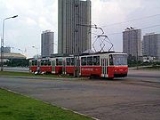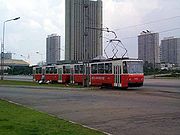
Pyongyang Tram
Encyclopedia

Tram
A tram is a passenger rail vehicle which runs on tracks along public urban streets and also sometimes on separate rights of way. It may also run between cities and/or towns , and/or partially grade separated even in the cities...
system in Pyongyang
Pyongyang
Pyongyang is the capital of the Democratic People's Republic of Korea, commonly known as North Korea, and the largest city in the country. Pyongyang is located on the Taedong River and, according to preliminary results from the 2008 population census, has a population of 3,255,388. The city was...
, North Korea
North Korea
The Democratic People’s Republic of Korea , , is a country in East Asia, occupying the northern half of the Korean Peninsula. Its capital and largest city is Pyongyang. The Korean Demilitarized Zone serves as the buffer zone between North Korea and South Korea...
.
In the pre-war
Pre-war
The term pre-war or prewar is usually applied to the most recent or significant war in a culture's history.Antebellum is most often used to denote the period before the American Civil War while pre-war typically refers to the period before WWII.In real estate the term refers to buildings from the...
era, there were three tramways in Korea
Korea
Korea ) is an East Asian geographic region that is currently divided into two separate sovereign states — North Korea and South Korea. Located on the Korean Peninsula, Korea is bordered by the People's Republic of China to the northwest, Russia to the northeast, and is separated from Japan to the...
, in Seoul
Seoul
Seoul , officially the Seoul Special City, is the capital and largest metropolis of South Korea. A megacity with a population of over 10 million, it is the largest city proper in the OECD developed world...
, Busan
Busan
Busan , formerly spelled Pusan is South Korea's second largest metropolis after Seoul, with a population of around 3.6 million. The Metropolitan area population is 4,399,515 as of 2010. It is the largest port city in South Korea and the fifth largest port in the world...
, and Pyongyang
Pyongyang
Pyongyang is the capital of the Democratic People's Republic of Korea, commonly known as North Korea, and the largest city in the country. Pyongyang is located on the Taedong River and, according to preliminary results from the 2008 population census, has a population of 3,255,388. The city was...
. However, the system in Pyongyang was discontinued after the Korean War
Korean War
The Korean War was a conventional war between South Korea, supported by the United Nations, and North Korea, supported by the People's Republic of China , with military material aid from the Soviet Union...
of 1950 to 1953. Those in Seoul and Busan survived the war, but were discontinued when motor cars became more common in South Korea
South Korea
The Republic of Korea , , is a sovereign state in East Asia, located on the southern portion of the Korean Peninsula. It is neighbored by the People's Republic of China to the west, Japan to the east, North Korea to the north, and the East China Sea and Republic of China to the south...
in the 1960s, leaving no tramways on the peninsula.
Unlike South Korea, personal ownership of automobiles in Pyongyang is very rare. North Koreans rely mainly on public transport
Public transport
Public transport is a shared passenger transportation service which is available for use by the general public, as distinct from modes such as taxicab, car pooling or hired buses which are not shared by strangers without private arrangement.Public transport modes include buses, trolleybuses, trams...
. As oil imported into the country is mostly allocated to its military, Pyongyang has electrically powered trolleybus
Trolleybus
A trolleybus is an electric bus that draws its electricity from overhead wires using spring-loaded trolley poles. Two wires and poles are required to complete the electrical circuit...
es (Pyongyang trolleybus system
Trolleybuses in Pyongyang
The Pyongyang trolleybus system forms part of the public transport network of Pyongyang, the capital city of North Korea, and extends to some of its suburbs.In operation since 30 April 1962, the system is presently about long and comprises 10 routes....
) and subways
Rapid transit
A rapid transit, underground, subway, elevated railway, metro or metropolitan railway system is an electric passenger railway in an urban area with a high capacity and frequency, and grade separation from other traffic. Rapid transit systems are typically located either in underground tunnels or on...
(Pyongyang Metro
Pyongyang Metro
The Pyongyang Metro is the metro system in the North Korean capital Pyongyang. It consists of two lines: the Chŏllima line runs from Kwangbok station in the southwest to Ragwŏn station in the northeast, and the Hyŏksin line runs north, from Puhŭng station on the banks of the Taedong to...
) as its main public transport. However, as trolleybus lines became overcrowded, the city decided to build tram lines. The first line opened in 1991.
In the late 1990s, the city had frequent power outage
Power outage
A power outage is a short- or long-term loss of the electric power to an area.There are many causes of power failures in an electricity network...
s due to decrepit power station
Power station
A power station is an industrial facility for the generation of electric energy....
s and the lack of resources. The tram lines also suffered from outages, but the situation improved in recent years. In 2003, however, the section of Line 1 between P'yŏngyang-yŏk and Songsin was closed, as the bridge over Taedong River
Taedong River
The Taedong River is a large river in North Korea. It rises in the Rangrim Mountains of the country's north. It then flows southwest into Korea Bay at Namp'o. In between, it runs through the country's capital, Pyongyang. Along the river are landmarks such as the Juche Tower and Kim Il-sung...
got older.
Foreign tourists were previously not permitted to ride the tram lines, but some recent tours have started to include tramway rides.
In 2008, the City Transportation Company of Prague sold 20 used T3s to Pyongyang Public Transportation Enterprise together with a shipment of tram-rails. These trams were made in late 1970s and the early 1980s. According to Ondřej Pečený, a spokesman for the City Transportation Company of Prague, these trams are in very good condition, and can run for at least two years without the need of a service.
The tram cars were made by Tatra
CKD
A knock-down kit is a kit containing the parts needed to assemble a product...
, a Czechoslovak
Czechoslovakia
Czechoslovakia or Czecho-Slovakia was a sovereign state in Central Europe which existed from October 1918, when it declared its independence from the Austro-Hungarian Empire, until 1992...
company, during that nation's socialist era. Various types are used, including low floor cars.
North Korea also has a tramway in Chongjin
Chongjin
Ch'ŏngjin is the capital of North Korea's North Hamgyŏng Province and the country's third largest city. From 1960 to 1967 and again from 1977 to 1985, Ch'ŏngjin was administered separately from North Hamgyŏng as a Directly Governed City...
, which opened in 1999.
Lines
There are currently three lines in operation.- Line 1: P'yŏngyang-yŏk — Man'gyŏngdae
- Line 2: T'osŏng — Rangrang — Munsu
- Line 3: Sŏp'yŏngyang — Rangrang
As of 2006, the fare is ₩
North Korean won
The won is the currency of North Korea . It is subdivided into 100 chon. The won is issued by the Central Bank of the Democratic People's Republic of Korea...
5 for any section. There are also coupon tickets .
Kŭmsusan Line
There is another tramway used to take visitors to the Kumsusan Memorial PalaceKumsusan Memorial Palace
The Kumsusan Memorial Palace, sometimes referred to as the Kim Il-sung Mausoleum, is a building located northeast of downtown Pyongyang, the capital city of the Democratic People's Republic of Korea . The palace is the former official residence and office of North Korea's president and founder,...
, where late President Kim Il-sung
Kim Il-sung
Kim Il-sung was a Korean communist politician who led the Democratic People's Republic of Korea from its founding in 1948 until his death in 1994. He held the posts of Prime Minister from 1948 to 1972 and President from 1972 to his death...
lies in state. The line is completely different from other lines in Pyongyang, and not connected to any of them. The line is free of charge. This tram line uses rail gauge
Rail gauge
Track gauge or rail gauge is the distance between the inner sides of the heads of the two load bearing rails that make up a single railway line. Sixty percent of the world's railways use a standard gauge of . Wider gauges are called broad gauge; smaller gauges, narrow gauge. Break-of-gauge refers...
, unlike others with rail gauge. The tram cars for this line were made in Switzerland
Switzerland
Switzerland name of one of the Swiss cantons. ; ; ; or ), in its full name the Swiss Confederation , is a federal republic consisting of 26 cantons, with Bern as the seat of the federal authorities. The country is situated in Western Europe,Or Central Europe depending on the definition....
.
See also
- List of light-rail transit systems
- Pyongyang MetroPyongyang MetroThe Pyongyang Metro is the metro system in the North Korean capital Pyongyang. It consists of two lines: the Chŏllima line runs from Kwangbok station in the southwest to Ragwŏn station in the northeast, and the Hyŏksin line runs north, from Puhŭng station on the banks of the Taedong to...
- Trams and trolleybuses in North KoreaTrams and trolleybuses in North KoreaTrams and Trolleybuses in North Korea are forms of public transportation for North Koreans to travel around in urban centres given the shortages on fuel and access to cars for average citizens....
- Transportation in North KoreaTransportation in North KoreaThe standard route to and from North Korea is by plane or train through Beijing, People's Republic of China. Transport directly to and from South Korea has been possible on a limited scale from 2003 until 2008, when a road was opened...
External links
- The Pyongyang Metro unofficial site
- www.stadtverkehr-plauen.de pictures and video of tram in Pyongyang
Further reading
- Hayato Kokubu, Shōgun-sama no Tetsudō: Kitachōsen Tetsudō Jijō , 2007. (ISBN 4103037318)

